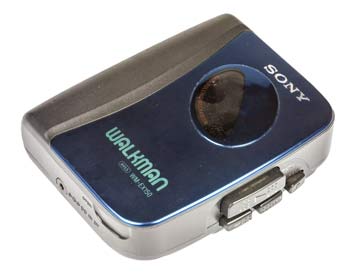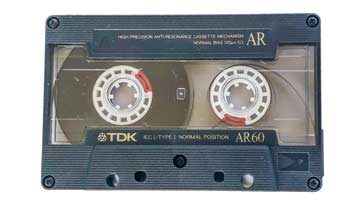The Sony Walkman Story - History of the Walkman Development
The Sony Walkman was introduced in 1979 and revolutionised the way people listened to music as it provided a means of listening anywhere and at any time
Sony Walkman History Includes:
Sony Walkman
WM-D6C Professional
WM-EX150
See also:
Sony Walkman
Apple iPod
It was back in the late 1970s that Sony launched a new audio cassette player that revolutionised the way we all listen to music.
Its effects are very much felt to this day as we are used to listening to music while we are on the move and almost anywhere.

The Sony Walkman was a revolution in its day and it was one of the most successful electronic products launched.
The Sony Walkman was a major milestone along the road to portable music which also included later products like the on-the-go CD players, MP3 players, and of course it set the foundations for today's mobile phones that give us music wherever we want.
Early beginnings
Before the actual introduction of the Sony Walkman, there were several other forms of tape machine that were made small so they could be portable.
A number of small dictaphones were designed - these were intended for executives to be able to dictate letters, correspondence and other documents that would later be types up in the office by a secretary.
Interestingly the first dictaphones were surprisingly early on - it was Alexander Graham Bell who is often credited with the invention of the telephone that produced the first dictation machines.
As time progressed these dictaphones (now a trademark of Nuance Communications) became much smaller and more portable, relying on modern tape recording technology to record the sounds.
Reel to reel tape recorders formed another foundation stone that set in place the foundations for the audio cassette and ultimately the Sony Walkman.
Reel to reel magnetic tapes were developed in Germany in the 1920s and 30s - initial machines used wires instead of tapes, but the concept of tapes soon arose to provide better and more convenient performance.
The early tape machines saw usage by the German forces in WW2, and after examples were captured with the fall of Germany in 1945 and this lead to their more widespread use and development.
Reel to reel tape technology was widely used for professional audio recording for broadcasting as well as the vinyl disc industry and many other areas. It also gained popularity for domestic and amateur recording.
However its use started to decline, initially in the domestic and amateur sector as a result of other more convenient recording formats.
Introduction of the audio cassette
The next key step before the Walkman could be developed was the introduction of the audio compact cassette.
These convenient tape cassettes were developed by Philips and first released in 1963.
Initially they did not capture the market in a big way, but as the 1960s progressed their popularity started to grow as more machines were introduced.

By the 1970s, audio compact cassettes were being used in a large way, both for recoding, and also as a means of buying pre-recorded music tapes.
These cassettes were also gaining popularity as a means of dictating and recording reports by journalists and others, and a number of very portable machines were introduced on top of those intended for domestic use.
Note on Compact Audio Cassettes:
Audio compact cassettes used tape technology to provide an easy and portable method or recording and buying pre-recorded music in a robust cassette for domestic and also commercial use.
Read more about Compact Audio Cassettes.
Birth of the Sony Walkman
The Sony Walkman development was initiated when the co-founder of Sony, Masaru Ibuka, asked for a way to listen to his music when he was travelling internationally by air.
He wanted something that was more convenient than the existing cassette players - something that could fit in a pocket or be carried much more easily. The existing portable cassette players were not suitable for use on the move in the way that Ikuba wanted.
Leading the team to develop the machine fell to a Sony designer named Norio Ohga. He built a prototype based around the Sony Pressman cassette recorder, and this was available for Ikuba's next flight. This was obviously a success with the co-founder because it was put into production.
This first Sony Walkman, the TPS-L2 was released on 1st July 1979 and it sold for 33,000 Japanese Yen which was about $150, but at this stage it was only available in Japan.
Initially Sony has expected sales of around 5000 units a month, demand soared and it sold over 30000 in its first two months.
The rest of the world had to wait for it to be launched in their countries. It was launched in the USA in June 1980 and later in other countries.
It was sold under different names in different countries: Sound-about in the United States, Freestyle in Australia and Sweden, and Stowaway in the UK.
However in the early 1980s the familiar name of Walkman was adopted globally and the name stuck - it even became a generic name for that type of equipment as many other companies started to see the opportunities.
The first offerings had two headphone sockets enabling two people to listen together as it was thought at the time that this might be needed. Also a 'Hotline' button was included on the TPS-L2 and this activated a microphone and partially muted the cassette playback sound to enable people to converse. At the time it was not good etiquette to walk around with headphones on oblivious to all around. How things have changed!
Another feature of the Walkman was the headphones. Pre-Walkman headphones were large and not suitable for use on the move. Sony designed some lightweight headphones that were convenient and portable.
Walkman further developments
After the first Walkman was introduced, Sony kept up the pace of its development. In 1981 its second unit was designed and released. designated the WM-2 it was much smaller than its predecessor and included a number of improvements. Also it did not have the 'Hotliine' button as this was not used.
Some later models had radios incorporated and in 1982 the first model with Dolby noise reduction was introduced.
Another notable development was the inclusion of auto-reverse, so that when the end of the tape was reached the machine automatically started to play the other side of the tape. This required a significant upgrade to the mechanics of the tape transport system in the Walkman.

Other developments after the cassette Walkman
The audio compact cassette and the Walkman associated with it led to a revolution in listening habits. With Walkmans and other similar cassette based players widely available people took having music available while on the move for granted.
With other new audio recording formats becoming available, equivalents of the Walkman were developed for these: a radio Walkman with only a radio receiver, a CD Walkman known as a Discman, a MiniDisc Walkman (who remembers the MiniDisc?), and others.
End of the Walkman
With the rise of other players as technology moved forward and left the cassette behind in terms of performance, sales of the cassette Walkmans fell.
Accordingly Sony started to discontinue the Walkman across the globe in different countries.
The last Walkman to be be sold in the USA was the WM-FX290W which was released in 2004.
In Japan, the home of Sony, the range was discontinued as late as 2010 This was a sad end for a line which had led the way in terms of personal music on the go.
Despite the fact that cassette Walkmans are not longer available new, they had revolutionised the personal music market and paved the way for streamed music and music availability in for things like MP3 players, iPods and the like and now music on mobile phones.
During the lifetime of the Walkman, Sony sold over 380 million of them - a truly colossal figure, and one that shows what can come out of small beginnings.
Examples of Walkman units
There was a colossal number of different Walkman machine types that were manufactured and it would be impossible to describe them all.
Instead, here are a few examples which give a good idea of what was available and what they looked like as well as how they performed.
• WM-D6C professional Walkman
The WM-D6C was introduced as a Walkman for professional applications. Its superior recording and playback quality along with its portability meant that it was used by very many people where high quality recording and playback were needed.
It was used in a variety of applications, including collecting audio for radio broadcasting.
• WM-EX150
This Walkman was launched around 1995 and followed the progression of Walkman cassette players.
The WM-EX150 Walkman offered a reasonable performance, bearing in mind its cost. It offered what most people wanted and it gave good reliable service.
The Sony Walkman series of portable cassette players revolutionised the way music was consumed. The Walkman series was aprticaulrly popular as exemplified by the number of companies that produced similar units. Nevertheless, the Sony Walkman was the first and definitely the most iconic unit to own.
 Written by Ian Poole .
Written by Ian Poole .
Experienced electronics engineer and author.
More History:
Radio history timeline
History of the radio
Ham radio history
Coherer
Crystal radio
Magnetic detector
Spark transmitter
Morse telegraph
Valve / tube history
PN junction diode invention
Transistor
Integrated circuit
Quartz crystals
Classic radios
Mobile telecoms history
Vintage mobile phones
Return to History menu . . .




